#Aptenodytes Patagonicus
Explore tagged Tumblr posts
Text

King penguin (Aptenodytes patagonicus) in South Georgia
Photographed by Luis Solano Pochet
#King penguin#Aptenodytes patagonicus#peguins#upl#art#photography#wildlife photography#animals#birds
122 notes
·
View notes
Text
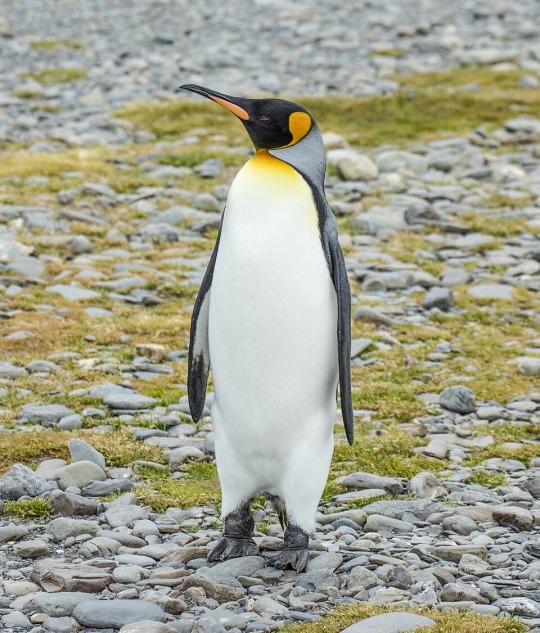


#poll#Class: Aves#Order: Sphenisciformes#Family: Spheniscidae#Genus: Aptenodytes#Aptenodytes Patagonicus
35 notes
·
View notes
Text

King Penguin
86 notes
·
View notes
Text
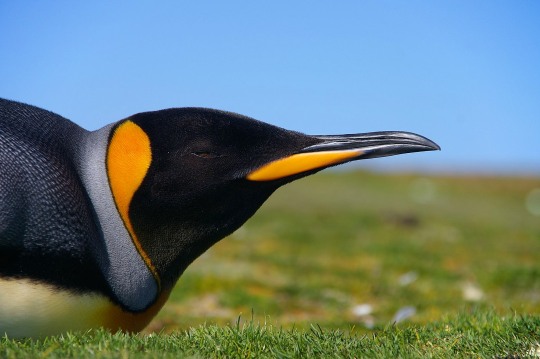
King Penguin (Aptenodytes patagonicus patagonicus), West Falkland.
35 notes
·
View notes
Text
Afternoon Snooze

A King Penguin catching forty winks in the former Jurong Bird Park. Photo credit: Jonathan Chua.
A stop of positive exposure compensation was used to lift the shadows of this snoozing king penguin. The camera had to be braced against a handrail as the shutter speed was a mere 1/50 second at ISO3200. Lighting was pretty dim in the air-conditioned penguin pen.
#photographers on tumblr#Aptenodytes patagonicus#bird photography#bird pics#canon 70-300mm#flora fauna#fujifilm photography#fujifilm x-t2#king penguin photos#photography tips
16 notes
·
View notes
Text





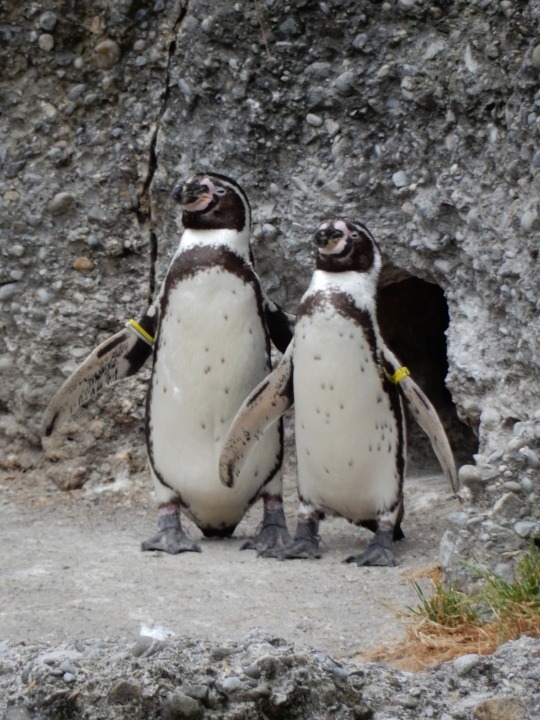













Penguin Awareness Day
Learn about these birds through documentaries, get up close and personal at your local zoo or donate to conservation charities working to protect them.
Penguins are fun and interesting animals that are unique in many different ways. There are currently over 18 different known species of penguin and some of them have been around the planet for well over 65 million years. They’re a beloved animal thanks to many popular depictions in movies and children’s stories, but they’re also fascinating birds that have piqued the interest of many people all over the world.
However, what most people don’t realize is that penguin numbers around the world are dwindling. Every year, the penguin population shrinks at an alarming rate and most of the world doesn’t realize this because they don’t get to see “real” penguins in their natural habitat. That’s why Penguin Awareness Day is such a good opportunity to learn more about penguins and understand the situation they’re in. It could lead to an appreciation for penguins and could even convince you to donate to help ensure that they can continue living on our planet for another 65 million years!
Penguin Awareness Day helps to bring some reality to people’s depictions of penguins that typically come from animated films and cartoons. Penguins are often seen as laid-back animals that love to swim around, take care of their children and socialize. This is a pretty accurate representation of what penguins do on a daily basis, but it doesn’t show the environment that the penguins live in and how it’s constantly changing around them.
Penguin Awareness Day is a time to celebrate and commemorate penguins, but unless we do something as a collective to help penguins thrive in the wild, there may be none left in the near future. That’s why the main focus of Penguin Awareness Day is to educate people on their situation, learn how climate change has affected them and also learn about the different species and where they live.
History of Penguin Awareness Day
Penguins are a barometer of the effects of human activity on the poles, according to scientists from institutions around the world. Raising awareness about them, therefore, is seen by many as a way to communicate with people about the impending dangers of climate change. If people can see how these birds are being affected, perhaps they will make changes to their lives.
Laboratories and scientific institutions worldwide became increasingly interested in Penguin Awareness Day after 2010. Their main aim is to highlight their penguin-related research and get the public interested in conservation.
For instance, Polito Lab released a video talking about what it was doing to study the lives of these lovable birds in Antarctica in 2017. LSU College of the Coast and Environment also jumped on the bandwagon, posting video content on Facebook. It featured short clips of penguins getting up to their usual antics with important messages posted over the top about how they live. According to the informational piece, penguins spend the majority of their lives either on the ice or in the water. Their colonies vary in size considerably, from just a few dozen to millions. Their diet is mainly krill and fish, and they create so-called “penguin highways” through the ice to make it easier to collect food.
Penguins, however, picky eaters. When you live in Antarctica, you have to consume whatever calories you can find, even if it is shrimp caught in the ice from years. Penguins need to consume specific types of food to keep their feathers and eggshells healthy. Scientists now say that they can take samples from these components and determine the quality of their diet. Now that’s quite an achievement!
In 2020, Cincinnati Zoo jumped on the Penguin Awareness Day bandwagon following the Twitter frenzy on the subject. The public amenity released a press release about the new habitat it had created for its blue penguins.
Penguin Awareness Day is, for that reason, an opportunity for everyone involved in the life of penguins to chip in and talk about this vital creature. Remember, the penguin is the largest animal to venture into the heart of Antarctica to breed. It is a tough little cookie and worth celebrating.
How to celebrate Penguin Awareness Day
Celebrating Penguin Awareness Day usually involves visiting a penguin exhibit at a local zoo. It’s a great opportunity to learn more about penguins, what they eat, how they socialize and also the environment they live in. However, it’s also a good opportunity to learn more about how climate change has affected them and what can be done to help their situation. You might get suggestions on charities that help penguins and donations are always appreciated to help their cause.
However, if you don’t have a local zoo nearby, then celebrating Penguin Awareness Day can be done indoors, even with your children. Penguin documentaries are a great way to learn more about penguins if you have teenage children, but if they’re still young and are expecting something fun and quirky for Penguin Awareness Day, then you could watch a penguin-related film together, even if it’s a cartoon. You can also watch videos on YouTube that talk about penguins and their situation to learn more about the wonderful species.
You can also think about donating to charities that specifically cater to the needs of penguins. The Global Penguin Society, for instance, does conservation work designed to protect the penguin’s natural habitat. It also advocates for the protection of the Southern Oceans – the principal place where penguins live. It wants to protect all eighteen species of wild penguins found throughout the southern hemisphere so that future generations can enjoy them.
Some charities also let you “adopt a penguin,” for a small amount of money every month. In return, you get regular updates on how your penguins are doing. And you can find out more about ongoing efforts to reduce fishing encroachment on their feeding grounds. Penguins are susceptible to fishing stock depletion so conservationists need to manage this carefully.
Lastly, you can also use the hashtag #PenguinAwarenessDay on social media to either learn more about penguins or even educate others about penguins and their situation.
Source
#Humboldt penguin#King penguin#Zoo Zürich#indoors#outdoors#day trip#Zurich#Schweiz#Switzerland#animal#original photography#tourist attraction#landmark#Penguin Awareness Day#20 January#travel#NationalPenguinDay#bird#aquatic flightless bird#Aptenodytes patagonicus#Spheniscus humboldti#flora#fauna#water#tree#grass#rock#2023
4 notes
·
View notes
Text

King penguins (Aptenodytes patagonicus)
Photo by Wim van den Heever
#Aptenodytes patagonicus#Aptenodytes#penguins#king penguins#birds#antarctica#sunset#colorful sunset#antarctic sunset#orange#orange sunset#purple#purple sunset#colorful sky#sunset photography#sky photography#sky#nature
14 notes
·
View notes
Text
Humboldt Penguins form mated pairs during the breeding season and nest in small colonies; they travel and feed at sea in social groups of 10-60 birds. King Penguins are highly gregarious, breeding in enormous colonies – some numbering 300,000 pairs – and generally form monogamous bonds. Gentoo Penguins have a similar social system, although their nesting colonies are not as large.
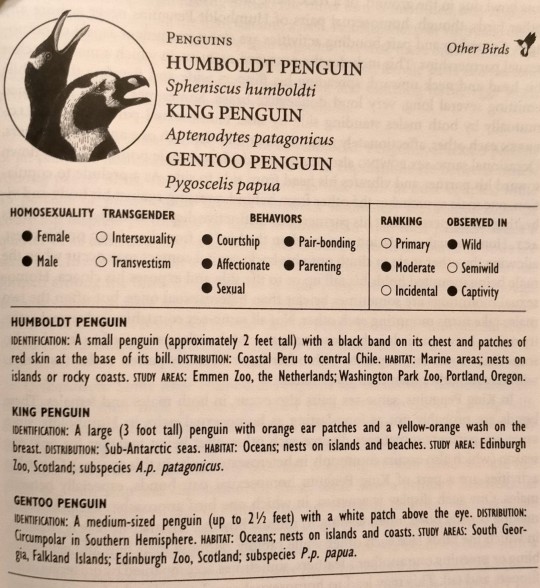
"Biological Exuberance: Animal Homosexuality and Natural Diversity" - Bruce Bagemihl
#book quotes#biological exuberance#bruce bagemihl#nonfiction#humboldt penguin#spheniscus humboldti#king penguin#aptenodytes patagonicus#gentoo penguin#pygoscelis papua#breeding season#nesting#colony#gregarious#monogamous#pair bonding
3 notes
·
View notes
Text
And researchers who discovered same-sex matings in Adélie and Humboldt Penguins and in Kestrels stated that they did not know if any comparable phenomena in other species of penguins or birds of prey, when in fact homosexual activity in King Penguins, Gentoo Penguins, and Griffon Vultures had previously been reported in the literature.
"Biological Exuberance: Animal Homosexuality and Natural Diversity" - Bruce Bagemihl
#book quote#biological exuberance#bruce bagemihl#nonfiction#researchers#same sex activity#adelie penguin#pygoscelis adeliae#humboldt penguin#spheniscus humboldti#kestrel#falco tinnunculus#comparable#phenomena#homosexuality#gay#lesbian#king penguin#aptenodytes patagonicus#gentoo penguin#pygoscelis papua#griffon vulture#gyps fulvus#scientific literature
4 notes
·
View notes
Text
Among King Penguins, birds in same-sex pairs are probably exclusively homosexual for the duration of their pair-bonds (since any eggs that are laid are infertile), and birds exhibit a "preference" for same-sex mates even when unpaired birds of the opposite sex are available. Overt the course of their lives, however, most such birds are sequentially bisexual, since following the breakup of a homosexual pair they may go on to form heterosexual pair-bonds and even raise a family.
"Biological Exuberance: Animal Homosexuality and Natural Diversity" - Bruce Bagemihl
#book quote#biological exuberance#bruce bagemihl#nonfiction#king penguin#aptenodytes patagonicus#bisexual#eggs#infertile
0 notes
Text

Inktober 2024 - Day 28 ✨
King Penguin (Aptenodytes patagonicus)
#art#artists on tumblr#my art#artwork#sketch#sketchbook#traditional art#traditional illustration#traditional drawing#traditional sketch#inktober#watercolourpainting#watercolour sketch#watercolour art#watercolour illustration#watercolor#birds of tumblr#bird art#bird drawing#bird#birds#birbs of tumblr#birb art#cute birbs#birblr
246 notes
·
View notes
Text
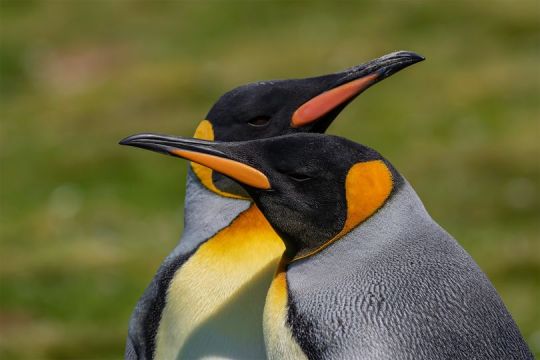
King Penguins (Aptenodytes patagonicus), family Spheniscidae, order Sphenisciformes, South Georgia Island
photograph by Thomas Kallmeyer
231 notes
·
View notes
Text
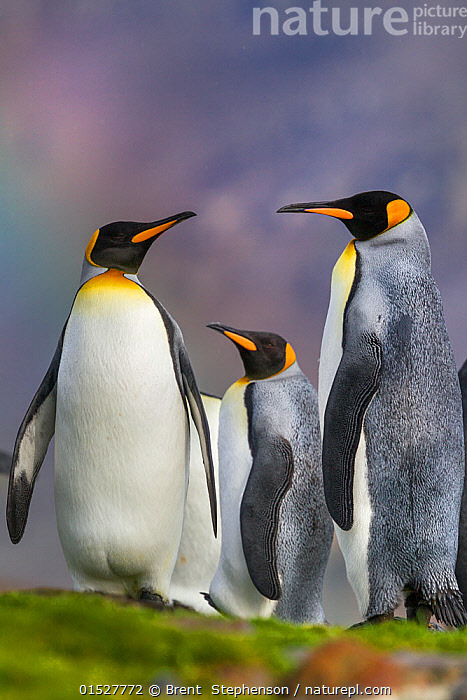
Three King penguins (Aptenodytes patagonicus) in light drizzle with a faint rainbow in the background, St Andrew's Bay, South Georgia, South Atlantic, January.
Photographer: Brent Stephenson
#brent stephenson#photographer#king penguins#bird photography#penguin#rainbow#st. andrews bay#south georgia#south atlantic#nature
21 notes
·
View notes
Text

King Penguin
41 notes
·
View notes
Text
Fossil Novembirb: Day 3 - Race to the Sea

During the start of the Cenozoic, the oceans were relatively empty. Gone were the great marine reptiles like mosasaurs and plesiosaurs, as were ammonites and many large predatory fish. As soon as birds could, they entered the ocean to reap its bounties, whether by flying over the surface or diving to the depths. This is especially evident in Aotearoa (New Zealand), where lots of early seabirds, including the first penguins, were found in Paleocene sediments dating about 62 million years ago.
Kumimanu: One of the largest known penguins, and one of the earliest, standing over 1,5 metres tall and weighing 90-150 kilograms.
Sequiwaimanu: Another early penguin, known from a skull that preserves a long, spear-like beak.
Muriwaimanu: A relatively small early penguin. Like other early penguins, it had relatively long legs and somewhat flexible wings.
Kupoupou: A small early penguin with derived traits, like a flipper-like wing and short legs.
Waimanu: The earliest known penguin, and also relatively large at the size of the modern king penguin (Aptenodytes patagonicus)
Protodontopteryx: The earliest known pelagornithid, large soaring marine birds. This earliest member of the family sports a "modest" 2-metre wingspan.
Clymenoptilon: An early representative of tropicbirds that may have lived somewhat like a tern.
#Fossil Novembirb#Novembirb#Dinovember#birblr#palaeoblr#Birds#Dinosaurs#Cenozoic Birds#Kumimanu#Sequiwaimanu#Kumiwaimanu#Kupoupou#Waimanu#Protodontopteryx#Clymenoptilon
45 notes
·
View notes
Text
Hail The King
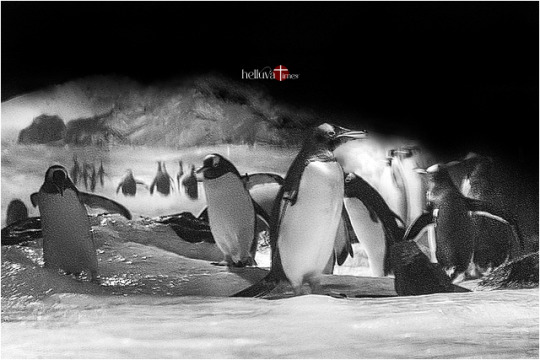
King penguins adjusting to their new habitat in the Bird Paradise. Photo credit: Jonathan Chua.
This Lumix camera, like some others, has the tendency to keep the ISO low (and the shutter speed along with it). So, there was actually a little motion blur visible in the original capture. Using ‘auto shake reduction’ as a fix in post raised the noise level to some 30. And applying noise reduction had turned the image into a little like a painting.
#photographers on tumblr#Aptenodytes patagonicus#bird photography#bird pics#black & white photography#flora fauna#king penguin photos#lumix photography#panasonic lumix dc-s1#photography editing#photography tips#sigma 18-300mm
19 notes
·
View notes